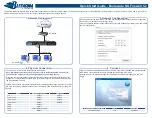
46
of packets, each packet can, if necessary, be sent by a different route across the
Internet. A packet is treated as an independent unit of data so packets can arrive
at their destination in a different order than they were sent in. Another protocol,
the Transmission Control Protocol, (TCP) then reassembles the packets in the
right order.
IP Address
- An IP address is a 32-bit number that identifies each sender or
receiver of information that is sent across the Internet. An IP address has two
parts: the identifier of a particular network on the Internet and an identifier of the
particular device (which can be a server or a workstation) within that network.
LAN (Local Area Network)
- A communications network that serves users within
a defined geographical area. The benefits include the sharing of Internet access,
files and equipment like printers and storage devices. Special network cabling
(10BaseT) is often used to connect the computers together. Wireless LANs use
wireless communications, in a home or office, to network all computers together
so there is no need to run an extra set of cables.
Line of Sight (LOS)
– Radio signals generally require a clear path between
antennas. Basically this means that the two antennas can be connected with an
imaginary straight string. There should never be any object blocking this line.
Multi-path
- Multi-path effects can be explained as coherent signals (signals
from the same source) arriving at the antenna at different times due to the
difference in path length.
PCI
- A local bus standard for connecting peripherals to a personal computer.
Within a computer, the bus is the transmission path on which signals and data
transfers occur between the CPU, system memory, and attached devices such
as a network card, sound card, or CD-ROM drive.
PCMCIA
- Personal Computer Memory Card International Association, which
develops standards for PC cards, formerly known as PCMCIA cards, are
available in three “types” which are about the same length and width as credit
cards, but range in thickness from 3.3 mm (Type I) to 5.0 mm (Type II) to 10.5
mm (Type III). These cards can be used for many functions, including memory
storage, as landline modems and as wireless LAN.
Roaming
- A function that allows one to travel with a mobile end system
(wireless LAN mobile station, for example) through the territory of a domain (an
ESS, for example) while continuously connected to the infrastructure. As a
wireless computer moves from an area served by one AP to another AP, the
connection is automatically switch from the first AP to the second AP. When the
change of connection occurs, there may appear to be a loss of connection at the
wireless station.










































